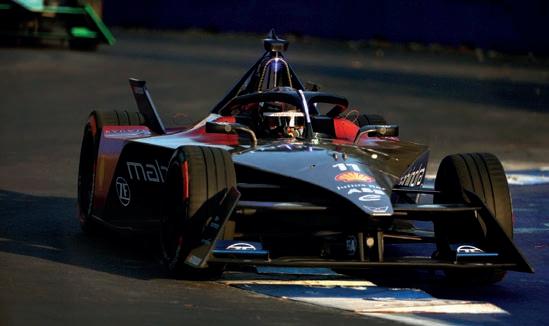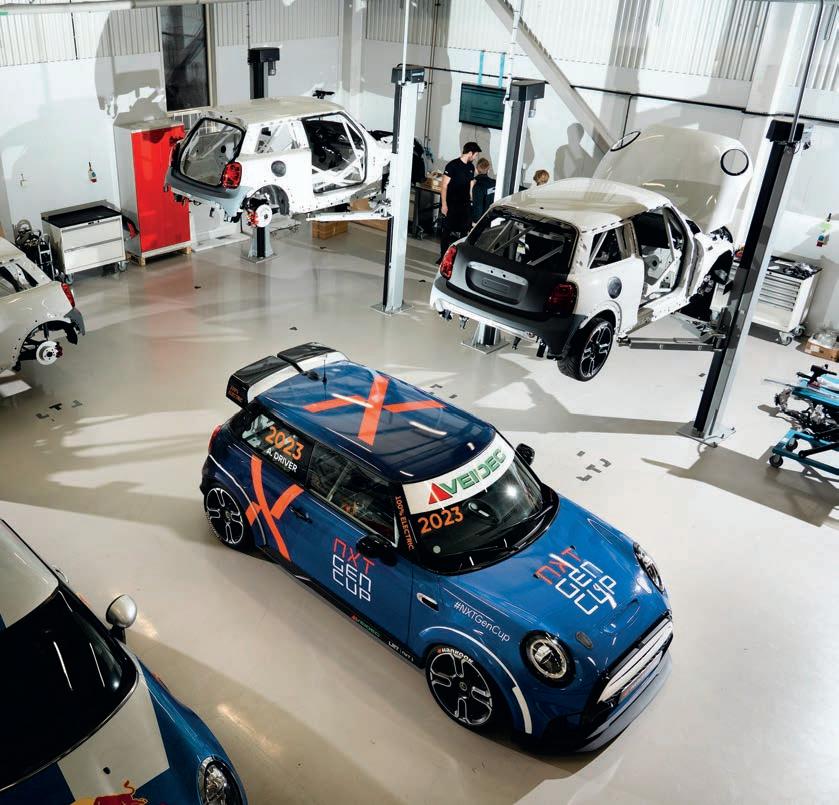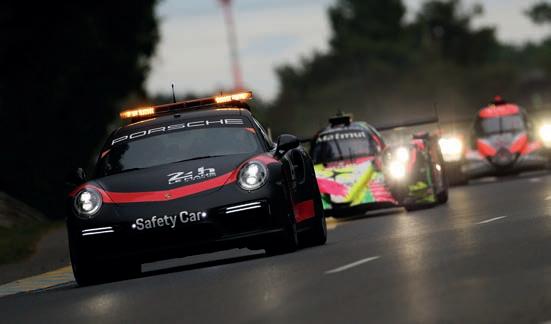
12 minute read
Taking the tube
Tubular steel is one of the most ubiquitous products in motorsport, but with tales of dubious materials on the market and a wide range of metals available, care must be taken when choosing and using pipe. Racecar investigates
By MIKE BRESLIN
Purchase a fake Rolex and you’re going to be out of pocket and may be late for work. Buy counterfeit high-spec steel for a spaceframe or rollcage build and the results could be much more serious. Because tubular steel, which even in this age of carbon is still at the heart of the vast majority of competition vehicles, is nearly always used in a way that’s vital for driver protection. It’s also used in great quantities. If you lay the tubing that makes up some rollcages end to end it can stretch for 40 metres, for instance.
But is there really a chance the steel you buy is not as advertised? Well, yes, but before we go into that, we need to fully understand what makes high-spec motorsport tubular steel so special in the first place.
Steels used in safety critical structures such as rollcages, or rollover protection structures (ROPS) will be either directly or indirectly mandated by regulations. Indirectly, in that a specified tube size with a specified strength might be stipulated, which often rules out the use of mild steel. This means that steels used in certain motorsport applications tend to be of a very high standard, often but not always to aerospace specifications.
Top of the pops
Some of the more popular high-spec tubular steels used include T45, 4130, 25CrMo4 and 15CDV6 (see box out on p57 for more details). But to get a general idea of how they’re produced, we will focus on T45 here.
Tim Rose, an engineering metallurgist and a senior research fellow and lecturer in the Department of Automotive Engineering at Cranfield University, a man who has studied the use of steel in rollcages, says of T45: ‘It’s a carbon manganese cold drawn seamless tube. The benefit is that it falls under aerospace specifications, so that the starting material, production, certification and quality assurance is much tighter (and more costly) than, say, commercial tube.
‘It’s also about two times the tensile strength of [regular] cold drawn seamless, so when homologating a ’cage it allows for smaller OD and wall thickness tubes to be used, which brings down weight. However, size for size, the weights will be the same.’
All steels are alloys – a mix of iron and carbon – but aerospace steels benefit from the addition of a pinch of an extra alloying element. In the case of T45, manganese.
‘This hardens the steel,’ explains Rose. ‘It makes it stiffer and increases its strength, but manganese content will be pretty low, 1.3 to 1.7 per cent of the weight of the material.’
Most tubular steels used in the motorsport environment also gain strength through a process called cold drawing.
‘Cold drawn means the tube is first hot formed through an extruder when the material is sufficiently plastic. Then you wait until it’s cooled down and tested, and then you pull it through a die. This is a strong material, so it requires a horrendous amount of force,’ says Rose. ‘But the process aligns the structure of the material, gets rid of any holes, defects or porosity, and just makes for a much stronger product, which is then treated as required subject to material specification.’
Though it is often the headline figure, tensile strength is just one of three crucial properties a motorsport steel needs, with yield and extension (or ductility) joining it in this Holy Trinity.
‘If you’ve got a piece of a material the size of a pencil, say, and you were to put that under load – so you fix one end of it and attach weights to the other – the tensile strength of that material is the most weight you could put on it until visible necking [reduction in diameter] starts to occur,’ explains Rose. ‘The moment that occurs, you know the weight that is on it, you know what the cross section is and so that is your tensile strength, in Newtons per square millimetre.’
Breaking point
The above is sometimes referred to, mistakenly, as a breaking point, but that’s also quite a good way to think of it in a way, in that it is a limit that can be reached. Yet how it’s reached is also important.
‘The higher the strength is, the more brittle it becomes,’ says Phil Matts, director product development at well-known UK motorsport steel supplier, Pro Formance Metals. ‘A rollcage, or rollover protection structure like this has also got to be designed so it soaks up energy.’



Which brings us neatly to yield.
‘Yield strength is when you load the material, it will extend, but if you take the load off, it will go back to its original length,’ says Rose. ‘It’s absolutely vital, and if you’re designing efficiently, you try and get to where yield, which is completely reversible, just transitions to plastic, which is irreversible. That’s your optimum point to design at, provided you’re fairly confident you’re not going to load it and turn it into plastic, where it becomes permanently deformed.’
The third property is elongation, which, says Matts, allows the material to bend. Something that is very useful when you’re trying to stuff up to 40m of steel tube inside the production ’shell of a Touring Car.
Basically, elongation is how much it can be stretched out without becoming more brittle or weaker, which brings other benefits beyond forming, Matts insists, using Pro Formance Metal’s own ROPT510 tubing (see box out) as an example of a steel with high elongation properties. ‘It carries an excellent elasticity, which allows the ’cages to be bent and formed, but it will also soak up energies,’ he says. ‘It will soak up more energies than any other tube on the marketplace, because the elastic limits are so much better.
‘Now, if we were to push the tensile strength up, to make it stronger, that will also push the elongation [down], which then reduces the elasticity of the material. And that’s where we didn’t want to go.
‘There are already materials in the marketplace that would do that, like our full aerospace designation BS4T45 to BS5T100 in accordance with BS6S100 condition tubing. They are a lot higher in tensile, but they’re a lot lower in elongation.’
Rigid peformance
The important thing to note here is that a stiff rollcage will bring performance – one BTCC engineer told this writer some years ago that the rigidity of the ’cage was worth the 70kg that came with it. Not all agree with that, though, which means there can be a tricky balance between two conflicting goals: ultimate safety and ultimate performance.


Joe Hickerton is a ROPS (rollover protection system) expert and technical manager at British governing body, Motorsport UK. ‘[A rollcage] is both a safety item and also a performance item,’ he says. ‘It will be used by an engineer to increase the performance of the vehicle, to stiffen the vehicle. Whereas from my point of view, I’m solely looking at the safety. It’s all about transfers of load. You don’t want it to be a completely solid structure.
It needs to absorb the loads of any impact or incidents in a way that transfers those loads away from the occupants of the vehicle.’
Forged steel
As we’ve seen, there are many variables to consider when choosing a tubular steel, but it’s interesting to note that much of the market seems to be driven by geographical and historical preferences. For instance, T45 is popular in the UK, while 4130 is the steel of choice in the US and 25CrMo4 in continental Europe. Each has its fans, and its detractors, but all should do the job required of it. What might not do the job is subtitute materials.






‘We’re seeing materials come into the marketplace that are being advertised as one thing, but some are totally different,’ warns Matts. ‘People will buy it off the internet, not even knowing where it’s coming from, and they are buying tubes from production facilities with no understanding of material usages, requirements or what the materials are designed for, which is very dangerous.
‘These tubes then come into the marketplace and are being sold as T45, with surface treatments that were never tested nor approved, such as grinding and polishing, which can lead to surface cracks and failures.’


Rose has also come across steel products that are not as high spec as they should be.
‘What has certainly happened in the last 10 years is that there are some iffy products kicking about that don’t appear to be any spec at all,’ he says. ‘It’s well known that China and the Far East have dumped a lot of stuff on the international markets, and they don’t dump their prime product, they dump the run-of-the-mill sort of stuff. And it’s obvious there are unscrupulous people out there that are trying to pass that off as a premium product, and a lot of times it goes unnoticed.’
Rose is also in no doubt this is not just a simple case of misidentification of steel.
‘I think it’s just as straightforward as “we know this tube looks like T45, we know it isn’t, but we’re going to label it as T45 and see you later,”’ he says. ‘I don’t think it’s any more sophisticated than that.’
Passing off
‘I’ve done a couple of failure investigations and have called for the full set of mill certificates [quality assurance documents used in the steel industry that state the physical and chemical properties of a material]. One company had bought some material and made some pressure vessels. I think they made about 10 or 12, and four or five of them bowed, blistered and cracked, and they shouldn’t have. When they showed me the mill certificates, they were all identical, so had clearly just been cut and pasted. I said one of these mill certificates is correct, and it applies to one batch of material, which I don’t think you’ve got. The others are worthless.
‘So, you need to be sure of your supplier, and have confidence that they are also sure of their supplier, if it’s anything safety critical.’
This is not just an issue that affects the club level racecar builder either, insists Matts. ‘We know of a ’cage purchased from a ’cage builder a few years ago by a WRC team. They bought it thinking they had bought a full spec ’cage, but it was this [copy] material.’
If a WRC team can buy a ’cage made from counterfeit steel, then anyone can, which suggests there’s an obvious safety issue here.
Motorsport UK was unable to comment on this matter at time of writing, but technical manager, Joe Hickerton did say: ‘We would always advise people, if they’re sourcing or building a rollcage, to ensure they know what the material is and to make sure they have traceability and bills of material.’
In some ways, in the case of rollcages at least, the risk of using a sub-standard steel has reduced somewhat because these days regulations often state that ’cages must come from reputable manufacturers who tend to be very careful when purchasing their steel.
‘In the last couple of years, FIA regulations have moved to requiring every new rollcage be a certified design, so moving away from the sort of build it at home approach,’ confirms Hickerton. ‘You must certify the design, so you’re putting on record all the details of what the design is and signing off each individual installation, which is then held on a database. That way there is a potential audit trail should we need it. There should be full traceability from the raw material all the way through to the installation into the car.’
Welding class
It’s not just the quality of the steel that can be an issue, though, there’s also the quality of the welding to consider. Willie Poole Motorsport, owned by former Mitsubishi and Mazda works rally team member, Willie Poole, has made a name for itself building and installing rollcages and also repairing crash-damaged race and rally cars.




‘When you fit the rollcage, you have to make sure you have a full 360-degree weld around the tube,’ Poole says, ‘but there’s a lot of people who fit rollcages and don’t fully weld them. Because they don’t know what they’re doing. They buy a rollcage and think they can do it themselves because they think it’s easy and anyone can do it. And then when they find out they can’t weld it all the way round, they just leave it. So, I’ve had a lot of cars come in for repairs over the years, only to find some of the tubes are only welded three quarters of the way around.’
This is something that Motorsport UK specifically briefs its scrutineers on.
‘The advice we give our scrutineers is that if it looks good, if the welds are of a good appearance and quality, then that’s the first good sign,’ Hickerton says. ‘Whereas if it’s a poor looking weld, then that’s where you need to perhaps be looking a little bit more closely. But it’s also checking the welds are complete, particularly in the roof area.
Mirror mirror
‘We have it from time to time where it’s not very easy to spot without mirrors, but this is the sort of detail we continually try to train our scrutineers to keep an eye on.’
When it comes to welding, Poole prefers TiG (tungsten inert gas) to MiG (metal inert gas).
‘I’ve never MiG’d a rollcage in my life. You get a nicer job with TiG. It’s more professional and I think you get a stronger weld as well. MiG weld, if it’s not done properly, looks as if it’s there, but it’s actually just sitting on top of the metal, whereas with TiG you can see you’ve got a pool there and you’re putting the rod into it so you know it’s fusing together.’
Rose, who began his working life as a welder, has recently completed some indepth studies on the welding of high strength steels, with interesting results.
‘If you’ve got material and the strength and integrity is improved, then that puts the onus of component safety on your joining process,’ he says. ‘So, if you get these double drawn, cold drawn tubes, and the material is highly anisotropic – that is, the grains are all set out in a particular way to achieve high strength – when you weld them you destroy some of that cold work that’s been put in.
‘It’s well known that there’s a penalty to welding, but just how big is that penalty? If you’ve got a tube that isn’t seriously affected, then your weld penalty is five to 10 per cent, if you have got a decent welder on hand. But if you have got a very high strength tube, and you weld it, then no matter how good the welder is, the potential for strength reduction becomes much larger, it’s 10 to 15 per cent.
‘Some [of our samples of high strength tube] cracked,’ Rose adds. ‘Sometimes they have cracked in the weld and sometimes they have cracked in the tube.
So, we’ve got a decent product, but how do we take those six metre lengths of tube and turn them into a safe rollcage or a chassis, or whatever, without compromising the fundamental mechanical properties of that high spec tube?’
The answer is that higher tensile strength tubes need far more attention when it comes to the welding ‘both in joint configuration and in the welding process itself,’ confirms Rose. ‘TiG welding, although one fifth of the speed of MiG, typically wins out here, although it needs a skilled welder to bring the best out of the process. The higher heat intensity and controlled filler addition enable a consistent weld pool to be achieved. This enables decent penetration into the two pieces being joined and reduced defects.’
However, a slower process means more labour time, which means higher costs, which is already often a significant factor with the higher spec tubing that is available.
‘The use of high tensile tubing needs to be balanced against cost and ease of fabrication,’ says Rose. ‘If there is only a small weight saving to be made, then lower strength tubes, MiG welded, may be the way to go. Also, the lower strength material tends to have higher ductility. It’s all a balance.’
Another thing to consider is that some high-strength steels need stress relieving after welding, and this cannot be carried out once fitted tightly inside a bodyshell, advised Matts, so again the materials used in the process need to be chosen wisely.
Whatever tube and welding method is used to construct them, steel rollcages will continue to be with us for the foreseeable future. But is there still a place for spaceframes in this age of carbon monocoques?
Formula future
Steve Wills, whose RSR concern is behind the tube frame Formula Foundation FF-E1 electric racecar (see RE V33N2) is well known for his expertise with this type of chassis.

‘I predicted 20 years ago that we wouldn’t be building tube frames today, but because of the marketplace, which is cash dependent, that has not happened.
‘On top of this, tube frame chassis are usually easier to fix after accident damage, while a well-built spaceframe is, arguably, as safe as a full carbon tub, and easily capable of passing tough crash tests, such as the FIA’s Appendix J Article 277.’
So, it seems most of motorsport will be sticking with steel for some time yet. But it should heed this warning from Tim Rose: ‘The need to have full, confident traceability on your steel has never been greater.’










